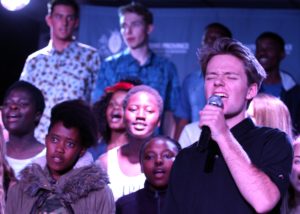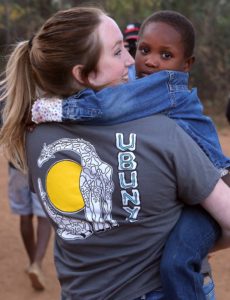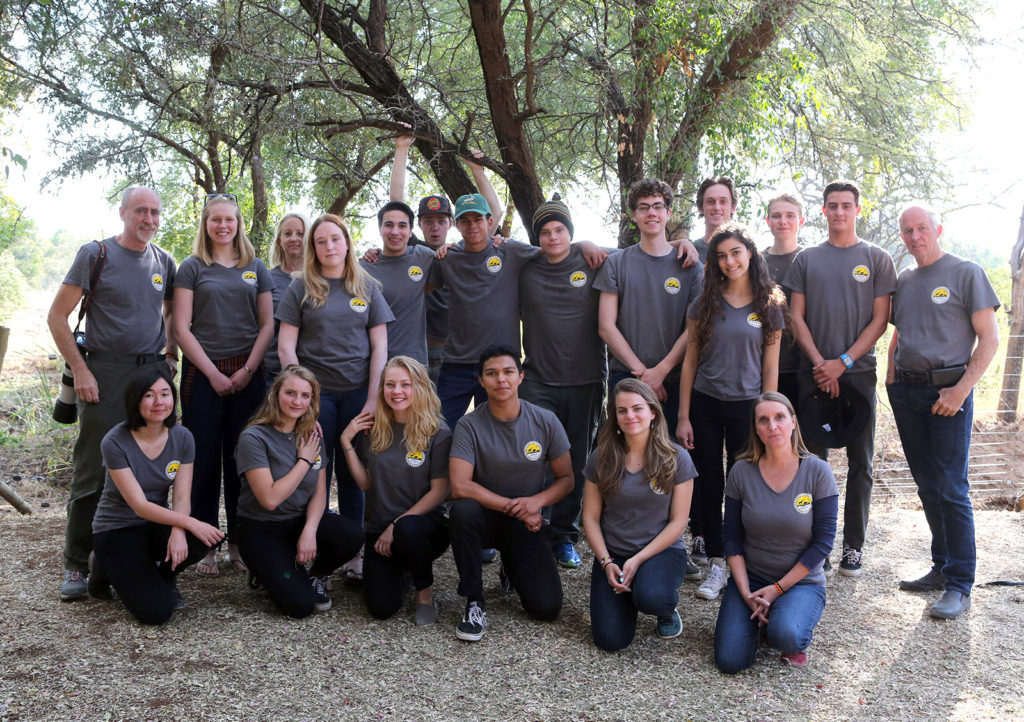An overview video of the Ubunye project which was played at the Return assembly for our community.
Filmed by Devin Kumar.
An overview video of the Ubunye project which was played at the Return assembly for our community.
Filmed by Devin Kumar.
A few reflections from the students after returning from their Learning Journey to South Africa.

If I had to reach inside my mind and fish out one of the millions of thoughts swimming back and forth across the oceans that separate me from what my life was just three weeks ago, I would probably end up holding an idea that I’ve always had in some way, but only recently came to see clearly: Time moves way too quickly. And I don’t mean it in a getting old, “Where did my youth go?” kind of way. I don’t want the ability to make time slow down, I want the ability to make it stop. I want to go back to the choir at Leap School, and stop at the exact moment I truly realized what I was hearing. I want to go back to Philani, running as fast as I could with laughing little kids on my shoulders. I want to stop at our final bow at Tembisa, the crowd cheering, surrounding us with a wall of sound. Almost a week after returning, I can remember vividly what I felt in each of those moments, but the feeling itself is gone.

While it’s too bad that I can’t stop at every mind-altering second in my life and take some time to enjoy and reflect on it, I discovered a different way to live in the moment on this trip. I’ve always been someone who thinks about the future constantly. I practically have my whole life planned out, and any time something happens that doesn’t fit in with that plan, it throws everything out of system. I never live up to the expectations I set for myself, and it makes me constantly unsatisfied. South Africa taught me how to stop planning. I found myself in a place I had never been, surrounded by things I had never seen, and instead of trying to figure out how it was all going to affect me, I let go. For the entire first week in Cape Town, I didn’t look at the schedule once. I never knew what was coming the next day, which made it impossible to expect anything. I found myself feeling freer than I had ever felt, no longer weighed down by my worries of who I’m going to be and whether I’ll succeed or fail. And maybe the other emotions are gone, but that feeling is still with me.
Sitting in my room, my mind is still in South Africa, but I’m very aware that my body isn’t. I’m not moving my gaze up the long neck of a giraffe in awe, I’m not watching excited kids pick out their new outfits at Botshabelo, and I’m not being immediately filled with joy at the contagious laughter of Archbishop Tutu, but I know that I once was, and really, that’s enough. Emotions don’t last forever. They’re always changing, but what will never change is the fact that I have experienced something that I will hold close to my heart forever, as time pushes me along way too fast. I did have one expectation going into this trip: that it would be life changing. I can say with absolute certainty that I was not let down.


The first meaningful moment that comes to mind when I think about the trip is my experience at Botshabelo. Marion Cloete was a truly inspiring person who has given me great confidence in who I am. She gave a speech about who she was and what she has done and what is still left to do to make the world an acceptable place. One thing she mentioned that stuck out to me was be and extraordinary ordinary person. She explained that anyone can change or help the world with love and compassion. This statement gave me comfort in the fact that no person is better or more important than another it just depends on the decisions and choices you make in your life. And to me the decisions that Marion has made and continued to make are truly inspiring and she is a hero to me. The most meaningful part of getting to meet Marion was coming to the realization that everything she did everyday was with someone else in mind. She was using her life to help others and not expecting a single thing in return. She was so humble when she spoke and wasn’t afraid to tell a group of 30 kids about all the times she was thrown in jail or arrested for being a term she called a “boat rocker.” She wasn’t scared to tell us who she was and how she feels. Throughout the trip there were many people who weren’t afraid to love themselves and that is something I am going to try my hardest to bring back with me.
Another moment that stuck out to me was when we were walking through the Langa township near the LEAP school and we walked into one of the rooms where three families were living. This room was about the size of my shower. In the room there were two twin beds with about 1 and a half feet in between. We learned that the older woman sitting on the bed had lived there for 40 years. My heart sank to find this out. I had read and heard about the townships, but until I was standing in one, it never truly sank in. The problem of poverty in South Africa is heartbreaking. To hear that 30 people were living in such a small space with so little made me feel so useless and unsure of a way to help. This moment stuck with me the whole trip: of looking into this woman’s eyes. A statement that Shannon made about the trip was that our class as well as many people living in California had won the lottery of life and I didn’t quite get that until I saw people that barely had the basic needs to survive. I took a step back and really thought about not only material things but the importance of my close friends and family and teachers that love me and give me opportunities. From the experience of seeing the townships, I want to continue to be appreciative and take opportunities when they come my way.
Filmed by Devin Kumar.
A few notes of thanks from each of us, for the people who helped make this project possible. And of course thank you to anyone not mentioned, as there are so many people who helped make the Ubunye Project incredible. We are currently on our way home to California after a wonderful learning journey. Each student will write a reflection on the trip, which we will post on the blog this summer.
A special thanks also to:
Nordic Naturals
Dr. Gallager
The Willis Parents
Grandma Kerr
Michelle Van Ooy
Jelli Beanz
Komala Correos
I am grateful for the Cloete family for creating Botshabelo and helping so many people. I am also grateful for the chaperones; SN, Shannon, Michelle, Shmuel, and Devin for making all this possible and making it a truly amazing trip.
-Cyrus Kamkar
I’m grateful for the opportunity to meet so many inspiring people like Peter Harris, the Cloete family, and Thulani Mbaso. I’m also thankful for the chance to have seen some of South Africa with my classmates.
-Emily Villareal
I’m grateful to Desmond Tutu, Thulani Mbaso and Pregs Govender for agreeing to speak with us despite their respective health difficulties, as well as for sharing their wisdom and experience with us.
-Lucas Caudill

It’s funny how your willingness to do certain things changes depending on the circumstances. Normally, if I had to wake up at 5:30 am to darkness surrounding me I would be groggy and grumpy. But when I had the opportunity to go on a safari and see the beautiful animals of South Africa, you can be sure I sprang out of my bed and got on my warmest clothes. It wasn’t just me who was ready to see the wonderful sights on the early morning excursion. I woke up to the sound of the outdoor showering running and Carl’s pristine voice singing an early morning tune. While Cyrus and I quietly got dressed in the front room, we both looked around at the lovely room we were staying in at the Black Rhino Lodge and he turned to me and said, “This is all sick dude,” with a big grin on his face. After we were all ready to leave, we headed out to the lounge where we met the rest of the group at 6:00 am. We were served coffee and tea before we headed out.
After the ten of us piled into the jeep, the people in the back immediately distributed the fleece lined ponchos, knowing the bitter wind would nip at our faces once we started our long, yet enjoyable, trek. The first animal we saw was the impala. Our guide, Daryl referred to them as the, “McDonalds of the bush.” Even though they’re so abundant in South Africa, every time I see one it still amazes my foreign eyes. They have a glistening coat and long ribbed antlers that twist upward like they’re grasping for the sky.
On this early morning safari ride we saw three of the “Big Five.” The “Big Five” include: elephants, lions, leopards, rhinos, and water buffalo. The first of the “Big Five” that we saw was a rhino, specifically a white rhino. We spotted this docile, peaceful creature grazing with its calf. She paid us no mind as we stopped 30 feet to the right of her and talked in hushed voices, marveling at the stout yet powerful beauty of her and her baby. The second animal of the “Big Five” that we saw was the elephant. I never thought I would see so much beauty in something that was so big, grey, and wrinkly. But to me no animal can compare to the massive magnificence of the elephant. I’ve seen elephants in zoos before but something about being so close to one and looking in its eyes made me see the quiet intellect yet brute strength that the elephant holds within it. We saw it pick up small bushels of shrubbery and strip them clean of the bark, their favorite snack. The third animal we saw was the lion. The lions we saw though were on top of a bunch of rocks and camouflaged by their surroundings. Our patient tour guide, Daryl, had to tell us step by step how to see them at least ten times because he could see our untrained eyes straining to identify where he was pointing. It was now that I regretted not bringing binoculars with me. Eventually, we were all able to spot not one but two females and one male that was lying in the sun on top of the rocks.
We also saw plenty of vibrant birds along the way and all had an amazing time. Overall, the elephant was my favorite animal and I’m exceedingly grateful I could see one so close and personal. We arrived and had breakfast waiting for us, quite the way to start a day.

We climbed aboard vehicles that closely resembled those from the Indiana Jones ride in Disneyland. So, I was excited. Only a little way into our journey we heard there was a sighting of a pangolin. Pangolins are basically scaly armadillos and they’re very rare because of the poaching that occurs in South Africa. When we arrived, there wasn’t a whole lot to see because it was flat to the ground and blending in, but moving closer you could see the scales and plates that formed the animal. It was a lucky first outing.
As the sun sank forming a rich orange background we also saw rhinos, wildebeasts, and impalas. Our guide was informative and elaborated on the necessary difference between black and white rhinos, one difference being that black rhinos are more likely to charge at you. Driving right alongside these huge rhinos our guide told us the disturbing fact that an average of four rhinos are killed every day for their horns. It’s sad that I’m seeing some of the few rhinos left. That’s why preservations like these are so important. South Africa has so much natural beauty, and I’ve only seen a small amount of it. Much of this trip has taught me how different it is to experience things for yourself than to be told about them or shown pictures. It was amazing to see these animals with my own eyes and not in The Lion King. I know that even the pictures I take home will never compare to viewing these beautiful animals in real life.

I like nature, probably more than the average person. When I get bored, instead of laying around or watching mindless TV, I’ll watch nature documentaries, with genuine interest. Seeing the animals in their natural habitat, hunting or exploring the ecosystem, can absolutely entrance me. Before I heard about the South Africa trip, I thought I would be stuck with the wildlife of costal California. Now, I can tell you from my own experience that seeing a lion, a cheetah, or even having a standoff with an elephant, will change your perspective on wildlife around the world. Waking up at 5:30 in the morning, getting in a 10-person jeep, and driving through blistering cold air at a speed known as “Ferrari safari” to see giraffes, is 100% worth it. These are animals that barely anyone can say they’ve seen in person. On television, you don’t get the real scale of these animals, the raw power an elephant uses to push over a good-sized tree. Then using its massive trunk, eat branches with the sharpest spikes like it’s mashed potatoes.
Some days, it would be bland, in comparison to the other safaris. You would see a wildebeest far off in a field, or one zebra on the side of a hill. Then, there would be the days where you would see a male rhino try and take on a female rhino and its kid, drive farther in the reserve, see three lions lounging around not ten meters from the jeep and on the way back see 15 mongooses bound across the road in a small herd. No matter what we saw on the safari, it would still be fun because I would get to hang out with my classmates and our Afrikaans jeep driver named Marcus. He could teach us something new about almost every animal and plant we came across. Whether it was showing us which plant could clear up congestion or debunking National Geographic, his knowledge of the world was always useful. I never thought I would be able to see these animals past my TV screen, but now I have memories that I won’t forget for my entire life. This was the perfect way to end the trip.


On the day before safari we visited the home of Chene Swart, a friend of Ward’s, who is a facilitator that specializes in “narrative therapy.” Narrative therapy is the process of re-evaluating one’s story, the life experiences that we generate, and deciding if it is still useful. If not, you can always change your story through reflection. Before lunch, Chene asked us five questions pertaining to our trip. Each question built off our previous answers. We were asked to choose someone to be our partner that we had not had extensive conversations with during the trip. I was partners with Phoebe, and we sat outside in the courtyard and went through the questions.
One of the biggest things that struck me about our conversation was the similarities in the things we had noticed. Another interesting aspect of conversing with someone I shared an experience with was seeing the differences between what they learned and what I learned. Through my conversation with Phoebe, I found validation for my own experiences. The whole conversation process kick-started my reflection process far earlier than when I usually begin to reflect on an experience and I can feel an increase in my awareness. Since the trip is chaotic, and one thing leads directly into the next, it can be difficult at times to distinguish individual experiences from the tangled mental mass of memories. Taking the time to reflect and talk about our trip really helped to separate the experiences, and capture what was truly significant. I will definitely apply aspects of this process to the reflection processes later in my life.
A video of our day at the Botshabelo Children’s Village.
Filmed by Devin Kumar.

Tembisa was one of the most beautifully hectic experiences of my life. We had to create a 15-20-minute show with singing and dancing, in the short span of three days. All while meeting new people, learning new songs, and trying to fit into a culture that we still weren’t quite used to, even after two weeks of being in South Africa. Throughout the experience, I was never sure that we were going to pull it together. A lot happened in those three days, but I’m going to try to put it all into words as well as I can.
On the first day, Monday, we arrived at the community center to practice our songs. The room we practiced in was a lot smaller than I expected, and a lot fewer people than I expected were singing with us. We went through our usual routine of introducing ourselves, not being able to pronounce anybody’s name, and failing to do their complex and interesting handshakes. It was a little bit awkward at first, but everyone was extremely friendly and comfortable, so we softened up a bit eventually. That was also part of the routine. We met Thulani, the music director, and I was relieved to see that he had a clear vision for the music, since none of us had any idea what we were going to do for the performance.
Thulani had us sing what we knew for him, and he seemed impressed, but our confidence was weakened a bit when he had his choir sing. They couldn’t have had more than 20 people, but they sounded just as big, if not bigger than the other much larger choirs we had heard during the trip. Part of it might have been the small room we were in, but it was clear that there was some serious talent there to help us.
We practiced for almost three hours. It was super fun at first, and it all sounded amazing since their choir was so powerful and we could basically just follow along. Nothing was too difficult, and none of the questions Thulani asked me about the music were too hard to answer. However, towards the end, we hit a huge roadblock. The way we sang the final song, Shosholoza, and the way the Tembisa choir sang it was completely different. Thulani clearly had an idea of how to join our versions together, but he was having a lot of trouble communicating it to us. It was the first time on this trip that I felt like there was a language barrier. We didn’t really figure it out, and even though the rest of the music sounded great, we left Tembisa feeling discouraged and hopeless. I then heard that Thulani was leaving Johannesburg to go do some performance elsewhere, and we weren’t going to have a music director. I had no idea how we would put it all together without him there, and I dreaded coming back for the next day’s rehearsal.
When we returned on Tuesday, our worries only grew when we found out that we had to perform that day, as well as the day after. I had no idea that we were supposed to perform any other day than Wednesday. We didn’t feel prepared at all, even after we practiced a bit beforehand. It turned out that we only had to sing the two easiest songs out of the four we were preparing, but the fact that it was all so new still made it a pretty daunting task.
We walked on stage. Somehow, they managed to fit a stage and at least 100 people in the room we had been practicing in, and the lights drowned out the crowd enough to let us pretend they weren’t there. I wasn’t as nervous as I thought I would be. Maybe the fact that we didn’t really know what we were doing lowered our expectations a little, but I just wasn’t thinking it would go badly at all, and it didn’t. The show went smoothly and we all felt great right after, but there was more for us to watch when we were done.
At that point, we had been in a very different country for a long time, but the culture shock didn’t truly hit me until the show that followed ours. The Tembisan kids stayed on stage, and performed an elaborate and intricate string of musical numbers, dance pieces, and scenes that completely blew me away. I’ve been to a few loud concerts in my day, but the sound from those didn’t even compare to the power of the Tembisa choir. Two of the kids were hitting a couple of drums so hard that I could practically feel myself being blown back by each slap. And it was perfect. Not a single mistake was made. I had to keep remembering to pick my jaw up from off the floor.
Two parts of the show stand out in my memory as being particularly different from anything I’ve ever seen. One was a traditional indigenous dance routine done by three guys and three girls wearing clothing made of hides. The drummers were playing faster than I thought was possible, and the dancers exerted so much energy. Everyone was in tune rhythmically. I don’t know how they were all able to find the same tempo so quickly without looking like they had to think about it. Everyone was in the moment and having so much fun, it was impossible not to smile and do some dorky dance moves in my seat. The other part that stood out to me was on the other end of the emotional spectrum. Two of the kids, a boy and a girl, did an extremely dramatic scene about the death of the baby of the girl’s character. The acting was amazing, and had all of us completely entranced, but the rest of the crowd kept laughing. This was not the type of scene that any of us would’ve ever laughed at, but apparently, everyone else saw it as some type of dark comedy. Surrounded by laughter on an island of confusion, I felt more out of place than ever before. It was clear that I was watching something different from the rest of the crowd, and that feeling is still very hard to describe.
After the show was over, we ate dinner with the Tembisan kids. I talked to one of the drummers, and he taught me a few grooves that he played. Even after I stumbled through them, he insisted that he was impressed with me. I talked with a few more people, and saw more of the same thing. Everyone I met was so talented, but so humble. I realized that most of the people we’ve met don’t like to show off or brag about their talent, because to them, it’s not talent. Music is part of who they are.
The last day was the longest, but the most fun by far. The ice between everyone felt officially broken, and we spent most of the day talking and joking with each other. We ran through the show, making fixes where we could, but Shosholoza still didn’t feel ready. We collaborated as much as we could, but by the end there was a general unspoken consensus that we were just going to wing it.
The performance of the final show might be the most fun I’ve ever had doing a performance of any kind. The crowd was so full of life, clapping and cheering at every opportunity. I couldn’t help but chuckle a little at how exciting it all was. When we sang a South African-ified version of “Stand By Me”, I sang a duet with one of the Tembisan girls named Ellen. The crowd cheered so loudly during it that I could barely hear myself. By the time it was over, I didn’t want to get off the stage, but I had to. We exchanged phone numbers with our new friends, and we got on the bus and left. Even though we had spent the whole day together, it all felt so abrupt. The show ended, and we may never see those crazy talented kids ever again.
This trip has been packed with eye-opening experiences, but our three days at Tembisa might just be my favorite. Looking back, it didn’t feel like only three days. So many things happened with us and those kids, and I feel like I’ve known them for months. They welcomed us into their musical world, and I’ll never forget what that world truly is. Music is the heartbeat of South Africa, and I hope I never stop hearing it.

Arriving at Tembisa, I was nervous for what was to come. We were going to meet a lot of new people our age and perform with them with only three days to rehearse. We were immediately thrown into rehearsal with the choir director, Thulani. When everyone started arriving, we were told to mix in so that we could meet new people. I stood in between two girls, named Ellen and Maya, who I quickly became friends with. We practiced all the songs, sometimes singing our version and sometimes singing their version. By the end of the first day we had a rough idea of what we would be doing.
On the last day of rehearsal, which was also show day, everyone was nervous that the show wouldn’t go well because it still needed a lot of work. We practiced for a few hours and then got to go walk around the surrounding township with our new friends. It was the most fun I had during this whole experience. It was nice to just hang out. It made me wish we had more free time to get to know the Tembisa students better.
When we got back, we did one fuller run through, still making stops to fix things here and there. I was very nervous when the show started but somehow, we did the whole thing with barely any mistakes. It went very well considering the amount of time we had. When it was time to leave, I was sad. I had become close with so many of our new friends and I didn’t want to leave knowing it would probably be the last time, at least for a long time, that I would see them. We gave our final goodbyes and hugs, and waved from the bus until we couldn’t see them anymore. I am going to miss hanging out with all of them. They were so friendly and welcoming that it was easy to become close with them quickly. I could only imagine what would have happened if we had more time together. I look forward to keeping in touch and hopefully seeing some of them again one day.

As our bus made its way through the streets of Tembisa for the second time in as many days, I was completely unsure what to expect. I seem to recall at some point hearing the term “dress rehearsal,” but I was completely unsure what exactly this entailed. All I knew is that, at some point, we would be singing. It was late afternoon, just before dusk, when we arrived at the intercultural exchange. As we entered the relatively small room where the performance was going to take place, I noticed that one end of the room had been transformed into a stage. Levels had been made from stairs and crates painted black, and stage lights hung from missing ceiling tiles. On the stage, our South African counterparts were mid-rehearsal. Their choir was singing softly and, though I could not understand the words, I could feel the power behind them. This singing accompanied a narration, which alternated between various actors and actresses. They were telling the story of Nelson Mandela’s release from Robben island, and the end of apartheid. I was instantly amazed at how passionately the performers on stage embodied their parts, and it wasn’t just the speakers, everybody participated fully. When the speaker described Mandela stepping before the South African crowd, all others whispered and gasped, staring and pointing past the audience, as if Mandela himself was standing in the room. When the speaker described the reaction of the press to Mandela’s release, everyone on stage dropped to their knees and held imaginary microphones to their mouths, chanting a question for Mandela in unison. This served to immerse the audience in the action, and, although it was just a rehearsal, I found myself totally drawn into their performance. Once they were finished, we were invited on stage with them, and we began to rehearse the songs we were performing together: Nkosi Sikelel’ iAfrika and We Shall Overcome. No sooner had we finished than I noticed the room start to fill. We made our way into the audience, and all lights but those illuminating the stage were turned off. Thus, the performance had begun. The show ran nearly an hour past its predicted ending time, but I found that I enjoyed the performances so much that I cared little. There were several pieces that were separate from the songs our group was involved in, including the performance we had walked in on, skits, songs, speeches and dances. There were two such performances that stood out to me as particularly well done, though all were fantastic. The first was a kind of skit portraying an argument between a male character and a female character. They were fighting about the fate of the female character’s baby, and a story began to unfold about a desperate mother without the means to take care of a child she didn’t ask for. I was absolutely blown away by the passion displayed by both performers. I specifically remember looking up at the actress and realizing that she was crying. This was something I had previously thought impossible in live theatre, and yet there she was, tears visibly streaming down her face. I was stunned. It no longer felt as though I was watching a performance, it was as though they had become the characters. The second performance was a Setswana Traditional Dance, which was unique in that it involved costumes. Admittedly, I was initially surprised when the dance began. One moment we were listening to a speech by one of the officials, then suddenly a woman walked on stage carrying what looked like a whip and wearing a skirt mad of animal skins. She began to chant, and she was quickly joined by two other women and four men who were similarly dressed. The group began to sing and dance simultaneously, stomping their feet in time with the drummers who were standing just upstage from the dancers. I was amazed by the precision of their movements. They danced perfectly in rhythm, synchronizing their movements with one another and gliding across the stage with grace that seemed to defy the physical limitations of the human body. It was thrilling to watch. I left Tembisa in awe of the production I had witnessed. I was amazed by the talent and dedication of all the students. In reflection, I feel grateful that I had the opportunity to watch and participate in the show, as well as the opportunity to meet people with such dedication to the thing that makes them happy.
You must be logged in to post a comment.